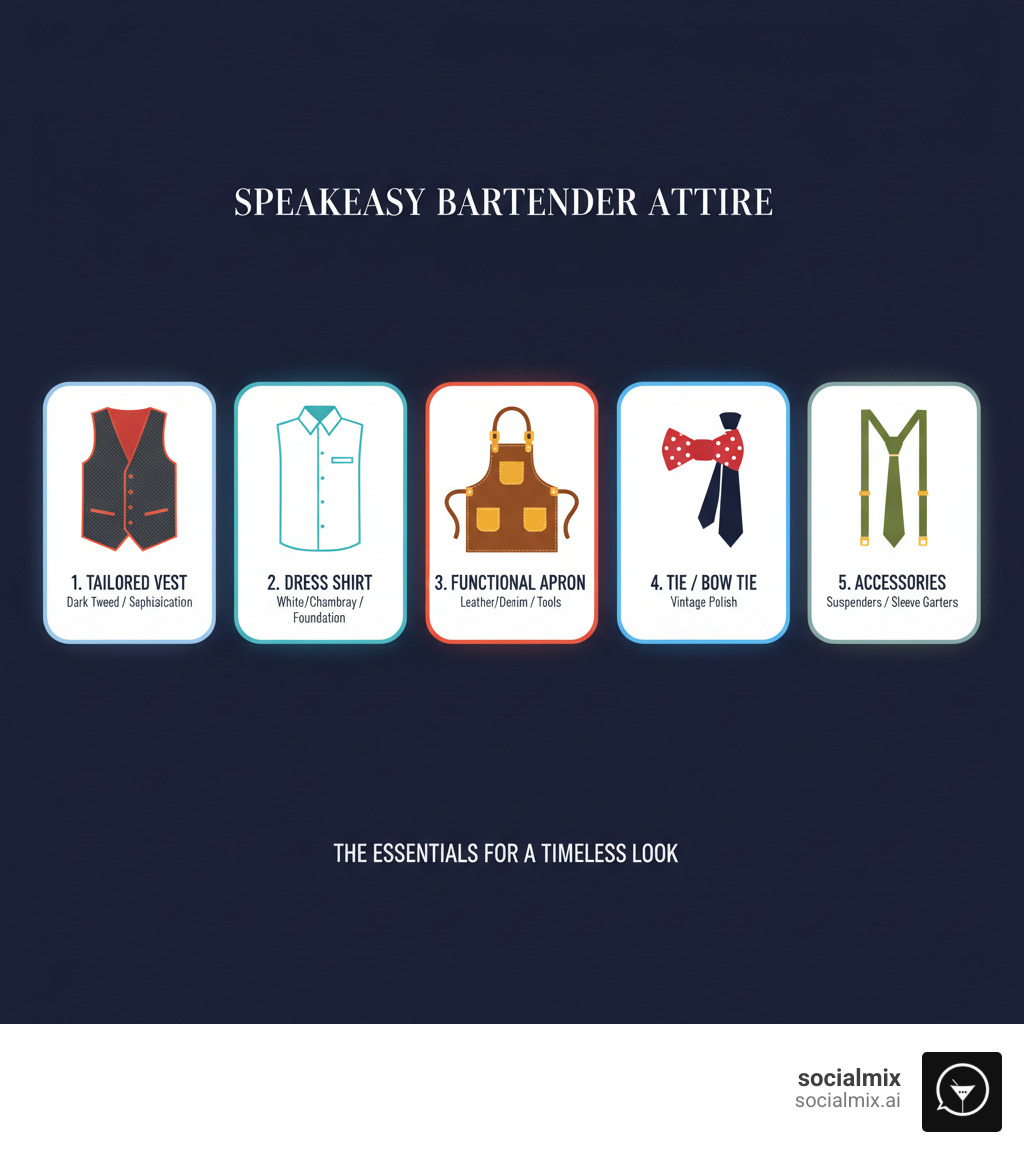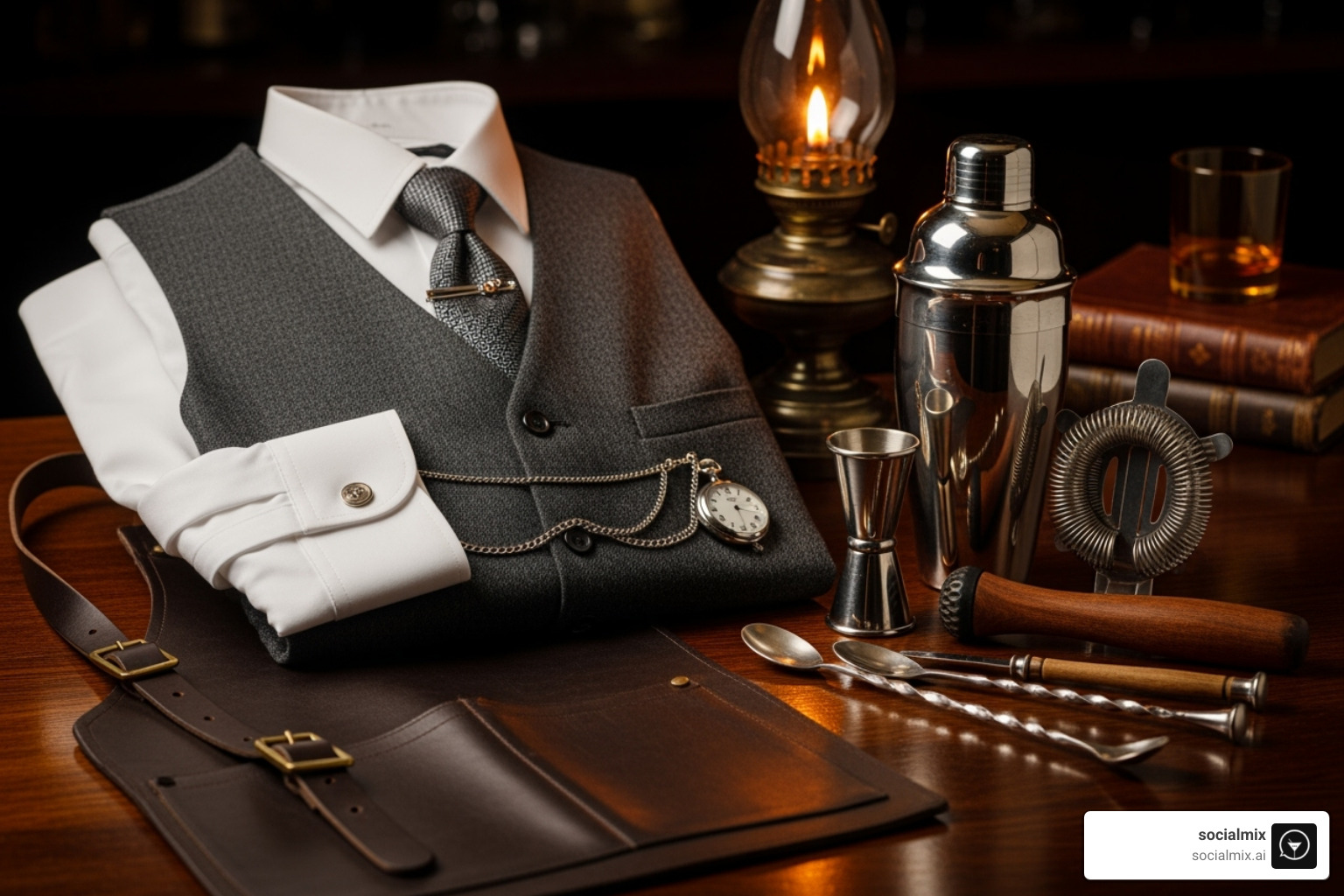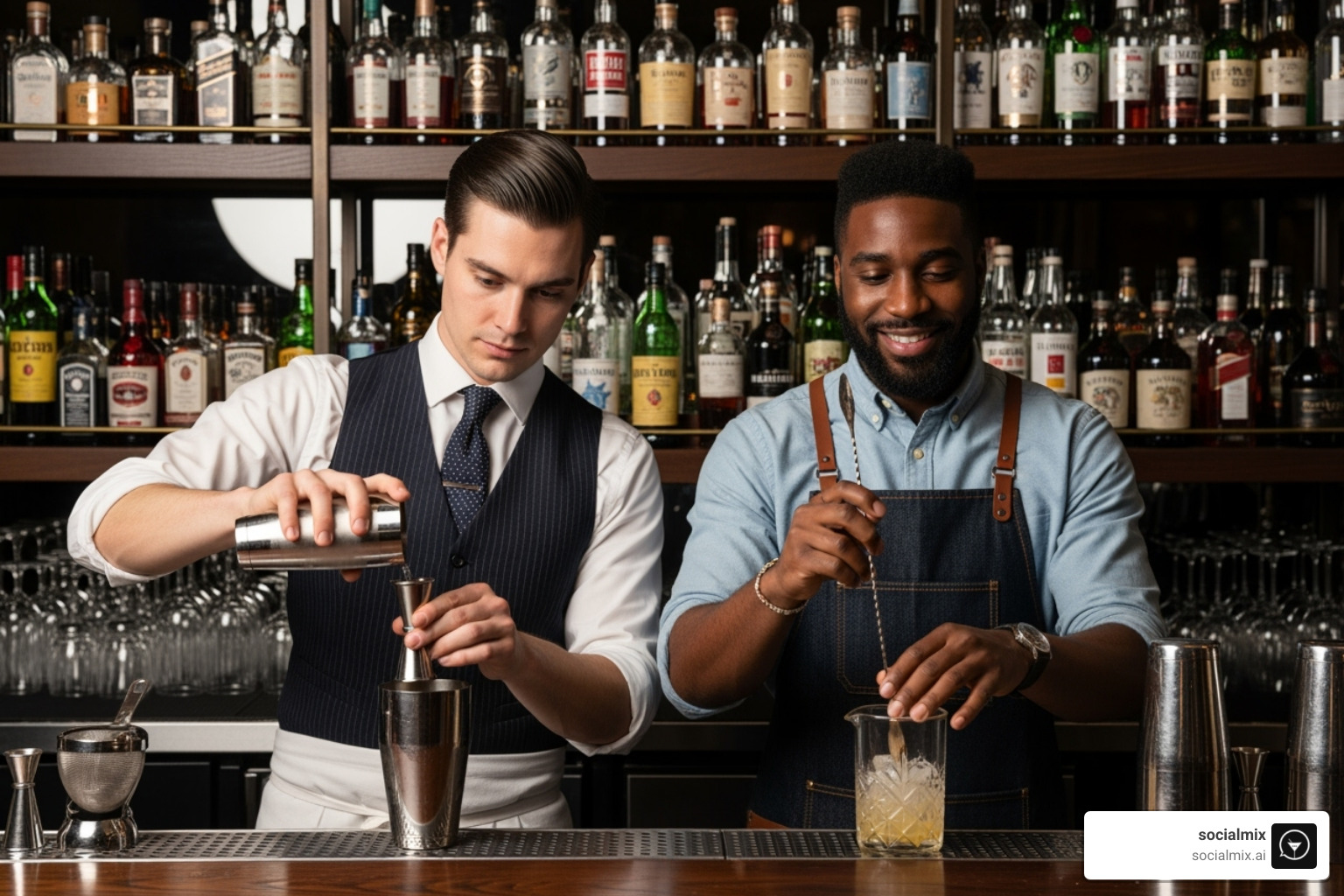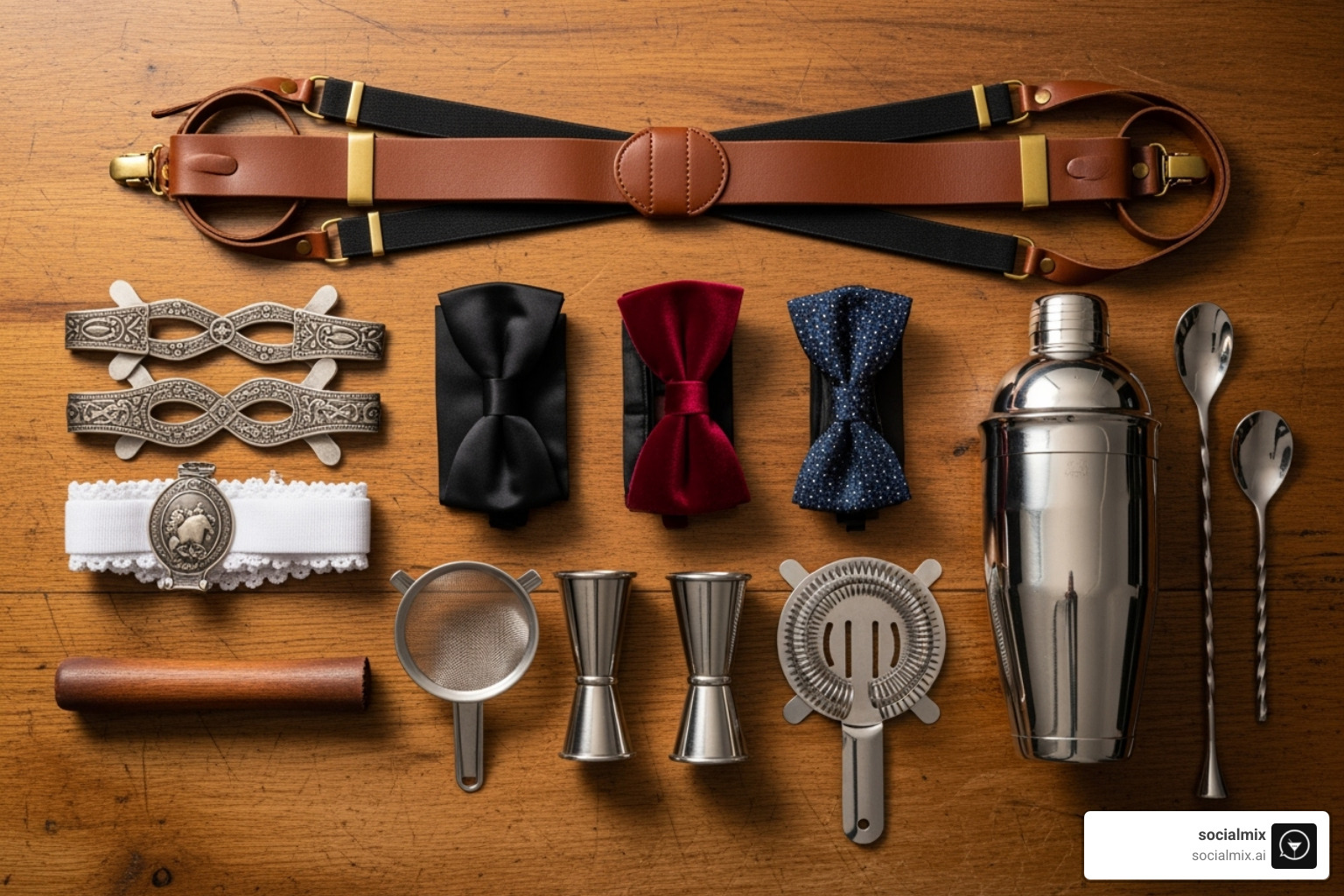Beyond the Bow Tie: How to Master Speakeasy Bartender Attire

Why Speakeasy Bartender Attire Matters More Than You Think
Speakeasy bartender attire is more than just clothing—it's a visual story that transports guests to the Prohibition era while creating an unforgettable brand experience. Whether you're opening a new cocktail lounge or refining your bar's aesthetic, the right uniform elements can make or break the atmosphere.
Key Elements of Speakeasy Bartender Attire:
- Vest or Waistcoat - Tweed, wool, or herringbone patterns in dark colors
- Dress Shirt - Crisp white or chambray with club collars or standard collars
- Apron - Leather, denim, or canvas (waist or bib style) for functionality
- Tie or Bow Tie - Adds vintage sophistication and polish
- Accessories - Suspenders, sleeve garters, or vintage-inspired details
When Sasha Petraske opened Milk & Honey in 1999, he didn't just revive Prohibition-era cocktails—he reintroduced a culture of service, including the fashion. As noted in a New York Times tribute, he insisted on "a dress code for his bartenders (vests and ties, with arm garters)." This attention to detail transformed how modern bars approach staff appearance.
Today's speakeasy-inspired bars walk a careful line between historical accuracy and modern functionality. Bartenders need to look the part and work a busy shift without overheating. The best uniforms blend vintage aesthetics with performance fabrics.
Your attire choices directly impact customer perception. Bars using speakeasy-inspired uniforms create stronger first impressions. At Nightjar in London, bartenders wear distinctive floral and denim aprons—a small detail guests remember. Meanwhile, Employees Only in New York keeps it classic with white jackets and denim waist aprons.
The difference between a costume and a professional uniform is comfort, functionality, and authenticity. Your team should embody the era without sacrificing their ability to work efficiently.

The Essential Wardrobe for Speakeasy Bartender Attire
Building the perfect speakeasy bartender attire is like crafting a balanced cocktail—it requires the right ingredients in the right proportions. The goal is to capture 1920s charm while ensuring bartenders can work comfortably.
Prohibition-era bartenders looked like polished professionals. In an era when serving alcohol was illegal, they styled themselves after pharmacists or barbers, projecting respectability and expertise. That's the essence we're recreating.

The core pieces—vests, dress shirts, trousers, and a functional apron—tell a story before the first drink is mixed. They are part of the clandestine, Prohibition-era atmosphere you're building. For more inspiration on authentic period styles, check out 1920s bartender attire.
The Foundation: Shirts and Vests
The shirt and vest combination is the backbone of authentic speakeasy bartender attire. Start with a crisp dress shirt—classic white is a winner, while soft chambray offers a relaxed take. A well-fitted shirt looks professional and allows for free movement. Some bars add a vintage touch with club collars, a small detail that impresses guests who appreciate authenticity.
The vest or waistcoat pulls the look together. It adds visual polish and keeps your bartender looking sharp. Tweed, wool, and herringbone patterns are ideal choices, with textures that evoke the Roaring Twenties. A well-fitted vest should follow the body's lines without restricting movement, as bartending involves constant motion. For a deeper look at period-appropriate tailoring, explore Roaring Twenties suits.
The Workhorse: Aprons and Trousers
While shirts and vests provide the look, aprons and trousers are where form meets function. Aprons are a major style element that also protects clothing. Leather aprons offer rugged sophistication, denim aprons provide a relaxed vibe, and canvas aprons are durable workhorses.
Both waist aprons and bib aprons work well. Bib styles offer more coverage and often have pockets for tools like jiggers and strainers, which improves workflow. For detailed guidance, read our guide on How to Choose the Right Bartender Apron.
For trousers, stick with dark colors like black, charcoal, or navy to hide spills. High-waisted pants can add an authentic vintage silhouette, but comfort is key. Bartenders are on their feet for hours, so trousers must allow a full range of motion. Modern stretch fabrics are a game-changer, offering flexibility with clean lines.
Materials and Colors: Crafting the Aesthetic
The right materials and colors sell the speakeasy atmosphere. Dark colors like black, charcoal, and navy are sophisticated and practical for hiding spills. Earth tones like deep browns and olives add warmth and vintage character.
Texture is just as important as color. Tweed has a rich, woven quality. Leather accents, especially in aprons, add rugged luxury. Denim works beautifully when paired with formal elements for a classic yet approachable feel.
For shirts, cotton or quality blends provide necessary breathability and comfort. Thoughtfully combining these materials creates a complete sensory experience, reinforcing your bar's theme. The fabrics become silent storytellers of Prohibition-era elegance. For more inspiration, explore Prohibition era fashion.
Then vs. Now: Historical Accuracy vs. Modern Interpretation
When you look at how speakeasy bartender attire has evolved from the 1920s to today, you're really witnessing a fascinating change in how we think about hospitality, branding, and what it means to look the part behind the bar.
Back during Prohibition, bartenders weren't trying to make a fashion statement—they were professionals doing a job, often in secret. Fast forward to today's craft cocktail renaissance, and the uniform has become part of the show itself, a carefully curated element of the guest experience.

The challenge is balancing historical accuracy with modern functionality. A bartender on a busy night needs to be comfortable, move freely, and stay clean—all while looking like they stepped out of a time machine.
| Historical Speakeasy Attire | Modern Interpretations |
|---|---|
| White coats (pharmacist aesthetic) | Performance fabrics with vintage styling |
| Formal dinner jackets and tuxedos | Vests and dress shirts with stretch materials |
| Strict uniformity and formality | Stylistic freedom within brand guidelines |
| Heavy, non-breathable fabrics | Moisture-wicking, durable materials |
| Limited functionality | Practical aprons with tool pockets |
The Original Speakeasy Look
During Prohibition, bartenders often wore white coats, giving them a clean, clinical appearance. This "pharmacist aesthetic" projected professionalism and trustworthiness, suggesting cleanliness and competence. It was similar to the attire of a soda jerk or barber.
As cocktail culture gained prestige, uniforms became more formal. High-end bars dressed bartenders in dinner jackets and tuxedos, elevating the profession. This tradition survives in legendary spots like Musso & Frank in Hollywood.
When Sasha Petraske opened Milk & Honey in 1999, he revived this formality. His bartenders wore vests and ties, signaling that something special was happening. This approach sparked the modern speakeasy revival.
Key Elements of Modern Speakeasy Bartender Attire
Today's speakeasy bartender attire blends past elegance with real-world functionality. The biggest shift is the use of performance fabrics that breathe, stretch, and hold up to a busy shift. A vest might look vintage but is often made with moisture-wicking materials. Trousers include stretch fibers for unrestricted movement.
What some call the "hipster bartender" look is actually thoughtful brand storytelling. The best modern bars use attire to create a cohesive visual experience. Nightjar in London uses distinctive floral aprons, reflecting its innovative but vintage-inspired concept. Speak Low in China uses uniforms that echo its French Concession-era theme.
Modern interpretations also allow for stylistic freedom. A bartender might choose a bow tie over a necktie or add personal cufflinks. This individuality, within brand guidelines, helps the team feel ownership over their appearance while maintaining a cohesive image. The goal is to capture the Prohibition-era feeling while ensuring bartenders are comfortable and effective. For more inspiration on how contemporary bars are approaching this challenge, check out Modern Bartender Uniform Trends.
Finishing Touches: The Power of Prohibition-Era Accessories
The right accessories are what separate a good speakeasy bartender attire from a truly memorable one. Think of them as the final garnish on a perfectly crafted cocktail—small details that make all the difference. These finishing touches don't just complete the look; they tell a story, add personality, and create those little moments of delight that guests remember long after their last sip.

Suspenders do more than hold up trousers; they create neat vertical lines and add a charming 1920s structure to the silhouette. They show a commitment to the era you're recreating.
Bow ties and neckties are another essential element. A crisp bow tie or a vintage-patterned necktie adds instant sophistication and formality without feeling stuffy. The beauty is in the variety—you can go classic with a black silk bow tie, or add character with unexpected patterns or colors. Bar Benfiddich in Tokyo takes a playful approach with mismatched bowties paired with plaid vests, reflecting their innovative spirit while maintaining that vintage charm.
Then there are sleeve garters, which might seem old-fashioned but are genuinely practical. In the 1920s, bartenders used them to keep their cuffs clean and out of the way—and that function still matters today. They solve a practical problem while adding an authentic period detail that guests appreciate.
Hats like fedoras or flat caps can complete the look, though they're often best reserved for greeting guests or special events rather than active service. For a deep dive into period-appropriate headwear, explore our guide to Roaring Twenties hats. And if you're looking to add even more authentic flair, check out Art Deco accessories for inspiration on vintage-inspired watches, cufflinks, and other details.
The key is choosing accessories that improve the theme without getting in the way of work. You're creating an experience, not a costume.
Grooming and Styling for the Part
Even the most perfectly assembled speakeasy bartender attire falls flat without proper grooming. Your outfit is only half the story—the rest is about presenting yourself with the same care and attention to detail that goes into crafting a classic cocktail.
Meticulous hygiene is non-negotiable. Clean hands, well-kept fingernails, and a fresh appearance are the foundation of professionalism and build guest trust.
Neat hairstyles complete the polished look. Longer hair should be tied back for hygiene and practicality. Facial hair should be well-groomed and trimmed. A neat beard or mustache adds vintage charm, while an unkempt one breaks the illusion.
The overall vibe should be understated elegance. You're not the star—the cocktails are. Look put-together without being flashy, and polished without being stiff. When grooming standards match the attire, you create a complete package that transports guests to another era. It's these details that transform a bartender into a time-traveling craftsperson.
Case Studies: Modern Bars Nailing the Speakeasy Look
It's one thing to talk about the ideal speakeasy bartender attire, and another to see it in action. Across the globe, some of the most renowned bars are masterfully using their uniforms to improve their brand identity and transport their guests to another era. These establishments prove that when you get the details right, the attire becomes part of the experience itself—not a costume, but a genuine expression of the bar's character.
In New York City, Employees Only has been setting the standard since 2004. Their bartenders wear crisp white jackets with an asymmetrical break line, paired with practical denim waist aprons. This combination strikes the perfect balance between Prohibition-era formality and modern functionality. The white jacket nods to the pharmacist aesthetic of early bartending, while the denim apron keeps things grounded and workable.
Across the Atlantic, Nightjar in London takes a more artistic approach to speakeasy bartender attire. Their team sports distinctive floral and foliage aprons over dress shirts, reflecting their innovative cocktail program while maintaining that essential vintage vibe. The uniforms tell guests that this is a place where tradition meets imagination.
In Shanghai, Speak Low fully commits to its concept with French concession-era attire. Bartenders wear vests, leather aprons, and ties that directly echo the bar's speakeasy theme and its historical setting, creating a deeply immersive experience.
The Dead Rabbit in New York City offers a slightly different take, leaning into its Irish pub heritage while maintaining speakeasy sophistication. Their bartenders don shades of green—often featuring logo tees under vests—that echo the pub's Celtic roots. This approach demonstrates how thematic attire creates cohesion and reinforces brand identity.
Finally, Bar Benfiddich in Tokyo shows us that speakeasy style can accept creativity and individuality. Their bartenders wear dress shirts with plaid vests and often mismatched bowties, adding unexpected splashes of color and personality. This eclectic approach perfectly mirrors the bar's innovative mixology.
What these bars teach us is that there's no single formula for perfect speakeasy bartender attire. Whether it's Employees Only's timeless white jackets or Bar Benfiddich's playful bowties, each establishment has found a uniform that authentically represents who they are. They all understand that what their bartenders wear is a visual calling card—one that sets expectations and creates atmosphere before a single cocktail is even mixed. For more insights on creating cohesive bartender looks, check out What Should I Wear: Bartender Outfits.
Frequently Asked Questions about Speakeasy Bartender Attire
You've got questions about speakeasy bartender attire, and we've got answers. The truth is, dressing the part shouldn't feel like a costume that gets in the way of great service. It's about finding that sweet spot where 1920s elegance meets the practical demands of a busy bar shift.
How can I make speakeasy attire functional for a busy shift?
Functionality comes from smart choices in fabrics and fit.
- Use breathable fabrics for shirts, like cotton or performance blends, to stay cool.
- Choose trousers with stretch for freedom of movement. Dark colors are practical for hiding spills.
- Invest in comfortable, non-slip footwear. Proper support is essential for long hours on your feet.
- Select an apron with functional pockets for tools. Leather, denim, and canvas are great options. For more guidance, see our guide on how to choose the right bartender apron.
- Use sleeve garters. They are historically accurate and practically keep your cuffs clean.
What are the key differences between historical and modern speakeasy bartender attire?
The spirit is the same, but the execution has evolved. Historically, attire was formal: white coats with a "pharmacist" look or, in high-end spots, formal dinner jackets. These outfits were sharp but often impractical.
Modern interpretations blend vintage aesthetics—vests, bow ties—with functional materials. Think durable denim aprons, stretch-cotton shirts, and moisture-wicking fabrics. The modern approach also allows for more personal style and brand expression, as seen in bars like Nightjar or Speak Low. It's less about rigid uniformity and more about creating an immersive experience. For more on this evolution, explore our post on modern bartender uniform trends.
Do I have to wear all the accessories like a hat and suspenders?
No. Accessories should improve the theme, not hinder the work. A well-fitted vest and a bow tie or necktie are often enough to capture that classic speakeasy charm. Suspenders are a great touch if they're comfortable, but well-fitting trousers work just as well.
Hats can be tricky. While a fedora or flat cap certainly adds to the period aesthetic, they're not always practical in a busy bar. Some bars reserve hats for special events or photo opportunities rather than everyday service. For inspiration on period-appropriate headwear, take a look at our guide to Roaring Twenties hats.
The bottom line? Choose accessories that fit your bar's specific concept and are practical for service. Your team should feel confident and comfortable, not constrained. For more guidance on putting together complete bartender looks, check out our post on what should I wear: bartender outfits.
Conclusion
Speakeasy bartender attire is far more than a costume; it's a crafted experience that begins the moment a guest arrives. Every element, from a tweed vest's texture to a leather apron's functional pockets, tells a story and transports people to another time.
We've seen this style evolve from the formal white coats of the Prohibition era to today's blend of vintage aesthetics and modern performance. The beauty of contemporary attire lies in this balance: honoring the past while embracing the practical needs of a demanding job. Bartenders must look sharp and stay comfortable.
The bars we've explored—from Employees Only to Nightjar—show there's no single "right" way to capture the speakeasy spirit. What matters is authenticity to your brand's story and commitment to your team's comfort. The uniform becomes a visual calling card, promising quality and attention to detail.
At socialmix, we believe great bartender attire improves social moments and strengthens connections. Our mission is to bridge cocktail culture with exceptional clothing, bringing style and sophistication to every shift. When bartenders feel confident and comfortable, that energy flows into the customer experience, creating memorable moments.
The right attire empowers your team to turn service into a performance and drinks into experiences. It's about personal expression, functionality, and style that makes a lasting impression.
Ready to transform your bar's aesthetic? Explore our complete guide to choosing bartender apparel and find how the right clothing can make every shift special. After all, it's these thoughtful details that guests remember most.




Leave a comment